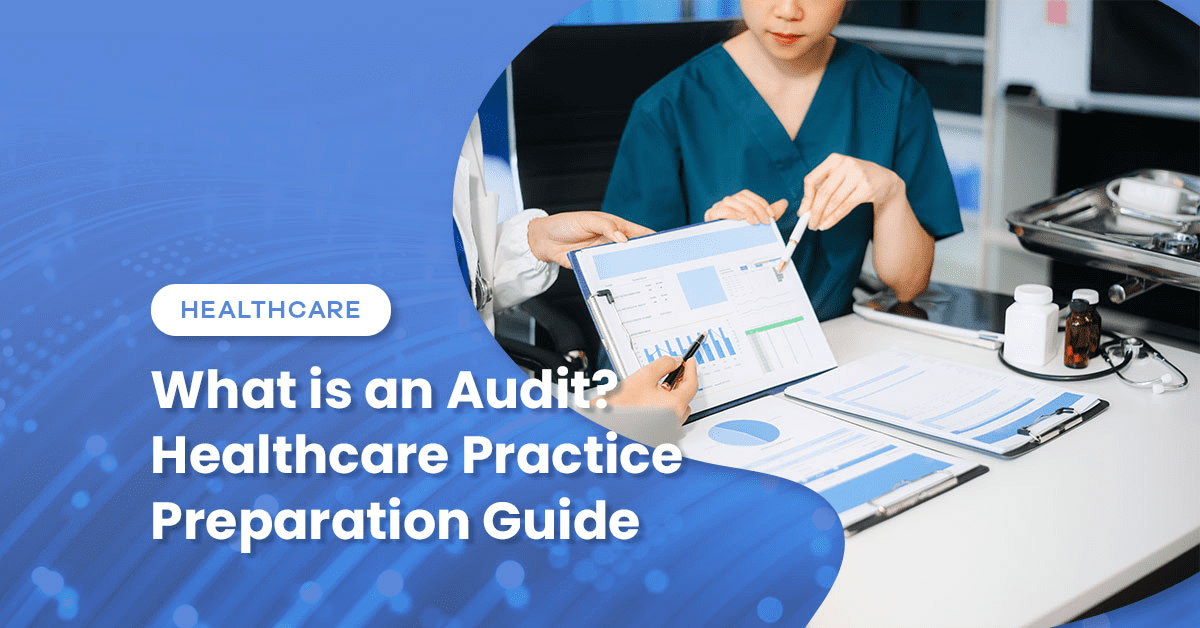Key Takeaways
- Healthcare practices face regulatory scrutiny annually: Financial statement audits reduce compliance risk by 67%, according to AICPA data
- ROI metric: Audit-ready practices spend less time on regulatory inquiries and payer disputes
- Strategic insight: Proactive audit preparation protects medical practice valuations during M&A transactions
- Bottom Line: Healthcare providers with documented financial controls avoid regulatory penalties and qualify for better lending terms
Your lender just asked for audited financial statements. Your incoming partner wants independent verification of practice value. A potential acquirer won’t move forward without three years of clean audits.
What is an audit in the healthcare context, and why does it function as a gatekeeper for every significant practice transaction? More importantly, why does everyone suddenly care about your financials the moment you need money or want to bring in a partner?
Allow us to walk you through it.
First, the basics:
For healthcare practices managing complex revenue recognition rules and regulatory scrutiny, the audit process validates financial accuracy—a factor that directly impacts practice valuations and lending terms. Translation: it proves your numbers are real, not aspirational.
What is an Audit in Healthcare?
An audit examines whether your financial statements fairly represent your practice’s financial position. The auditor tests transactions, evaluates internal controls, and assesses management’s accounting judgments to issue an opinion on the reliability of the financial statements. Think of it as a financial colonoscopy—thorough, occasionally uncomfortable, but ultimately revealing things you need to know.
The Three Audits Healthcare Practices Actually Encounter
Healthcare practices encounter multiple audit types, each serving distinct purposes:
Financial statement audits: Third-party validation for lenders and investors who trust your word but want verification anyway
Compliance audits: Assessment of adherence to Medicare, Medicaid, and commercial payer requirements—because apparently submitting claims correctly isn’t optional
Quality audits: Evaluation of clinical documentation and patient outcomes, where the government checks whether you’re actually practicing medicine properly
While all three impact operations, financial audits carry disproportionate weight in capital transactions and the restructuring of partnerships. Because nothing says “we trust you” quite like requiring independent verification of everything you’ve told us.
The distinction matters because stakeholders treat audit opinions differently from compilations or reviews. Audited statements carry the highest level of assurance, which translates directly to transaction velocity. Banks move faster. Partners negotiate more efficiently. Acquirers spend less time in due diligence when audited financials eliminate questions about baseline financial health. It’s the financial equivalent of providing references—everyone knows you’re probably fine, but they want someone else to confirm it anyway.
Data shows practices with annual audits secure financing faster than those presenting compiled statements. The external validation reduces lender risk assessment time and often results in more favorable borrowing terms.
Why Healthcare Practices Need Financial Audits
Regulatory and contractual obligations drive many audit requirements. Certain Medicare and Medicaid participation agreements mandate audited statements—because the government wants verification that your numbers match reality. Private equity firms require three years of audited financials before closing practice acquisitions, presumably because they’ve seen too many creative accounting approaches. Hospital systems evaluating employed physician models won’t proceed without independent financial verification.
When Lenders Demand Audits (Spoiler: Often)
Lenders impose audit thresholds tied to loan size and risk profile:
Commercial real estate lenders treat audited financials as standard underwriting requirements for medical office buildings.
Equipment lessors request audits for capital commitments above certain thresholds.
Every lender ever wants proof you can actually repay what you’re borrowing.
The pattern is clear: the more money you want, the more proof they require. It’s almost like they’ve lent money before and learned some lessons.
Partnership transitions create valuation needs that only audited financials can address. When physicians enter or exit ownership, fair market value calculations require objective data to ensure accuracy. Tax returns—optimized for minimizing liability—don’t reflect actual practice value.
Your audited financials show what you actually earned. CFOs report that practices with audited financials resolve partnership transitions faster because the financial baseline is already established and validated.
Risk management extends beyond compliance checkboxes. Annual audits identify internal control gaps before they escalate into fraud or significant billing errors. The review process surfaces revenue cycle issues that could trigger payer audits.
Documented financial controls demonstrated through a consistent audit history provide defensibility if regulatory questions arise. It’s preventive medicine for your finances—catching problems before they require emergency intervention.
The Healthcare Audit Process
Planning begins 90-120 days before the fiscal year-end. Your audit team defines scope, assesses risk areas specific to healthcare operations, and establishes deliverable timelines. For medical practices, auditors focus on the complexity of revenue recognition, assumptions regarding accounts receivable collectability, and payer contract compliance. They’re looking for where things typically go wrong in healthcare, because experience has taught them exactly where to look.
What You’ll Actually Need to Provide
Documentation requirements are substantial. Auditors examine:
Bank statements: Every account, every month
Patient billing records: Because revenue recognition in healthcare is delightfully complex
Payer contracts: All of them, with current rate schedules
Payroll documentation: Proving everyone on your payroll actually works for you
Vendor invoices: Verification that expenses are real and properly classified
Internal control documentation: Evidence that your financial processes involve more than one person making decisions
They also evaluate internal controls—segregation of duties, expenditure approval processes, and account reconciliation procedures. Healthcare practices must demonstrate clear separation between clinical decision-making and financial transaction processing. The person prescribing medications shouldn’t also be approving large vendor payments. The IRS and common sense both agree on this one.
Field work typically spans several weeks. Auditors select transaction samples to test accuracy and proper accounting treatment. They confirm bank balances, verify payer contract terms, and assess accounts receivable aging to determine appropriate reserve calculations.
Healthcare revenue cycles are subject to particular scrutiny because coding accuracy and contractual adjustment estimates carry a high risk of misstatement. Insurance reimbursement is complicated enough without creative accounting layered on top.
Final deliverables include audited financial statements, a management letter addressing internal control observations, and recommendations for improvement.
Practices with organized documentation and established controls complete audits more quickly than those addressing deficiencies during fieldwork. Being prepared saves time and money. This applies to audits, too.
Audit Preparation for Healthcare Practices
Financial record organization starts with disciplined month-end close procedures. General ledger accounts should reconcile consistently. Bank reconciliations must be current with all outstanding items documented and explained. Healthcare practices need organized payer contract files with current rate schedules and reimbursement term documentation. This is the financial equivalent of keeping your medical records organized—it seems tedious until you desperately need to find something.
Internal Controls That Actually Matter
Internal controls require clear documentation. Questions auditors will ask:
Who accesses billing systems?
Who approves vendor payments?
How do you handle patient cash receipts?
Does the same person who posts charges also process deposits? (They shouldn’t)
What compensating controls exist if you’re too small for complete segregation of duties?
Auditors expect segregation of duties—the staff member posting charges shouldn’t also process deposits. It’s not that they don’t trust your team. Actually, no, that’s exactly what it is. They don’t trust anyone enough to let them control both sides of a financial transaction.
Smaller practices without sufficient personnel for complete duty segregation need compensating controls, typically owner-level review of all financial activity. If you can’t separate duties, at least have someone checking the work.
Revenue cycle verification demands special attention. Your accounts receivable aging must reconcile to patient accounting system balances. Bad debt write-off policies require documentation and consistent application.
Auditors scrutinize patient refund processes, insurance overpayment handling, and charity care adjustments for appropriate accounting treatment. Every adjustment to revenue needs a documented, defensible reason. “It seemed right” doesn’t count.
The Healthcare Audit Red Flags You Can Fix Now
Common deficiencies in medical practice audits include:
Inadequate bad debt reserve methodology: “We think it’s about right” won’t satisfy auditors
Incomplete payer contract documentation: Missing contracts for your three largest payers creates problems
Insufficient controls over controlled substance inventory: The DEA and auditors both care about this
Revenue recognition timing errors: Recording insurance payments as revenue instead of when services are rendered
Aged receivables carried at full value: If you haven’t collected in 18 months, you probably won’t
Practices addressing these areas before field work begins reduce audit costs and avoid qualified opinions that raise concerns for lenders and potential partners. Fix problems before auditors find them.
What Auditors Examine in Medical Practices
Revenue recognition receives primary focus. Auditors verify that you’re recording revenue when services are rendered, not when insurance payments arrive, which can be between 30 and 90 days later.
They test whether contractual adjustment estimates align with actual payer reimbursement experience. Healthcare revenue cycle timing creates complexity that auditors examine carefully—because if there’s one thing insurance reimbursement excels at, it’s complexity.
Accounts receivable aging undergoes detailed analysis. Auditors assess whether your collectability assumptions withstand scrutiny. If you’re carrying aged balances at full value while historical collection rates suggest significant write-offs, auditors will require reserve adjustments that impact reported earnings. Your optimism about collecting that 24-month-old balance won’t survive the audit process.
Payroll classifications carry liability implications. Auditors verify the proper classification of employees versus independent contractors. Misclassification creates material tax exposure and legal risk. They confirm payroll tax deposits are accurate and timely. The IRS has strong opinions about who qualifies as a contractor, and those opinions come with penalties if you’re wrong.
Compliance documentation receives attention that extends beyond purely financial matters. Auditors review professional liability insurance coverage, DEA registrations for controlled substances, and state licensing status.
While not primarily financial issues, these compliance elements affect practice viability and asset protection. You can’t operate a medical practice without licenses, and auditors want proof that yours are current.
Partner with Healthcare Audit Specialists
Financial statement audits establish credibility for practice growth, partnership transitions, and regulatory compliance. The process validates financial health to external stakeholders while strengthening internal controls that protect against fraud and billing errors. Think of it as your financial clean bill of health—everyone asks for it, and having it ready saves substantial time and negotiating headaches.
Wiss Audit & Assurance brings four decades of healthcare expertise to medical practice audits. Our team understands the nuances of healthcare revenue recognition, the complexity of payer contracts, and the intersections of regulatory compliance with financial reporting.
We complete healthcare practice audits more efficiently than generalist firms while identifying opportunities to enhance financial operations. We also understand the difference between “accounts receivable” and “accounts we’ll probably never collect,” which apparently matters to lenders.
Ready to establish audit readiness? Contact Wiss Audit & Assurance for a healthcare practice financial assessment. Because discovering control weaknesses during an audit is considerably more expensive than addressing them beforehand.





 Previous
Previous



